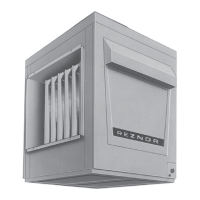Form I-X, P/N 150491 R7, Page 4
2.2 Combustion Air
Requirements
for a Heater
Located in a
Conned Space
FIGURE 1 - Conned
Space: A space whose
volume is less than
50 cubic feet per 1000
BTUH of the installed
appliance input rating
3.0 Uncrating and
Preparation
3.1 Uncrating and Inspecting
This furnace was test operated and inspected at the factory prior to crating and was in
operating condition. If the furnace has incurred any damage in shipment, document the
damage with the transporting agency and immediately contact an authorized Reznor
distributor. If you are a Reznor distributor, follow the FOB freight policy procedures as
published by Thomas & Betts for Reznor products.
Check the rating plate for the gas specications and electrical characteristics of the
furnace to be sure that they are compatible with the gas and electric supplies at the
installation site.
2.0 Furnace
Location
(cont'd)
WARNING: These furnaces are designed to take combustion air from the space in
which the unit is installed and are not designed for connection to outside combus-
tion air intake ducts. Connecting outside air duct voids the warranty and could cause
hazardous operation. See Hazard Levels, page 2.
Hazards of Chlorine
These duct furnaces are designed to take combustion air from the space in which the
furnace is installed. The air that enters into the combustion process is vented to the
outdoors. Sufcient air must enter the equipment location to replace the air exhausted
through the vent system. Modern construction methods involve the greater use of insu-
lation, improved vapor barriers and weather-stripping, with the result that buildings
generally are much tighter structurally than they have been in the past. The combus-
tion air supply for gas-red equipment can be affected by these construction conditions
because inltration that would have existed in the past may not be adequate. Exten-
sive use of exhaust fans aggravates the situation. In the past the ltration of outside
air assumed in heat loss calculations (one air change per hour) was assumed to be
sufcient. However, current construction methods may now require the introduction of
outside air through wall openings or ducts.
Requirements for combustion air and ventilation air depend upon whether the unit
is located in a conned or unconned space. An "unconned space" is dened as a
space whose volume is not less than 50 cubic feet per 1000 BTUH of the installed
appliance. Under all conditions, enough air must be provided to ensure there will not
be a negative pressure condition within the equipment room or space. A positive seal
must be made in all return-air connections and ducts. Even a slight leak can create a
negative pressure condition in a conned space and affect combustion.
Do not install a unit in a conned space without providing wall openings leading to and
from the space. Provide openings near the oor and ceiling for ventilation and air for
combustion as shown in FIGURE 1, depending on the combustion air source as noted
in Items 1, 2, and 3 below the illustration.
Add total BTUH of all appliances in the conned space and divide by gures below for
square inch free area size of each (top and bottom) opening.
1. Air from inside the building -- openings 1 square inch free area per 1000 BTUH.
Never less than 100 square inches free area for each opening. See (1) in FIGURE 1.
2. Air from outside through duct -- openings 1 square inch free area per 2000 BTUH.
See (2) in FIGURE 1.
3. Air direct from outside -- openings 1 square inch free area per 4000 BTUH. See
(3) in FIGURE 1.
NOTE: For further details on supplying combustion air to a conned space, see the
National Fuel Gas Code ANSI Z223.1a (latest edition ).
The presence of chlorine vapors in the combustion air of gas-red heating equipment
presents a potential corrosion hazard. Chlorine will, when exposed to ame, precipitate
from the compound, usually freon or degreaser vapors, and go into solution with any
condensation that is present in the heat exchanger or associated parts. The result is
hydrochloric acid which readily attacks all metals including 300 grade stainless steel.
Care should be taken to separate these vapors from the combustion process. This may
be done by wise location of the furnace with regard to exhausters or prevailing wind
direction. Remember, chlorine is heavier than air. This fact should be kept in mind when
determining installation locations of heating equipment and building exhaust systems.

